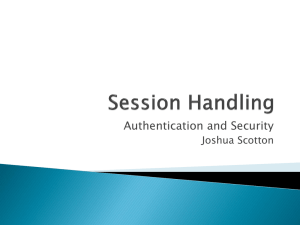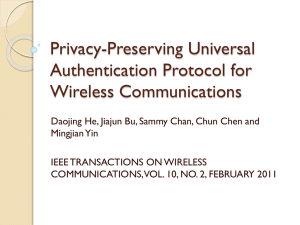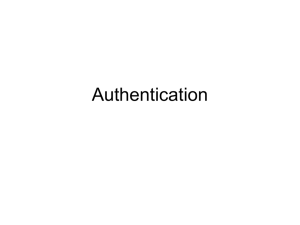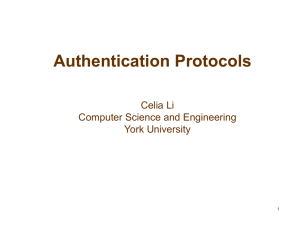Java web application security
advertisement
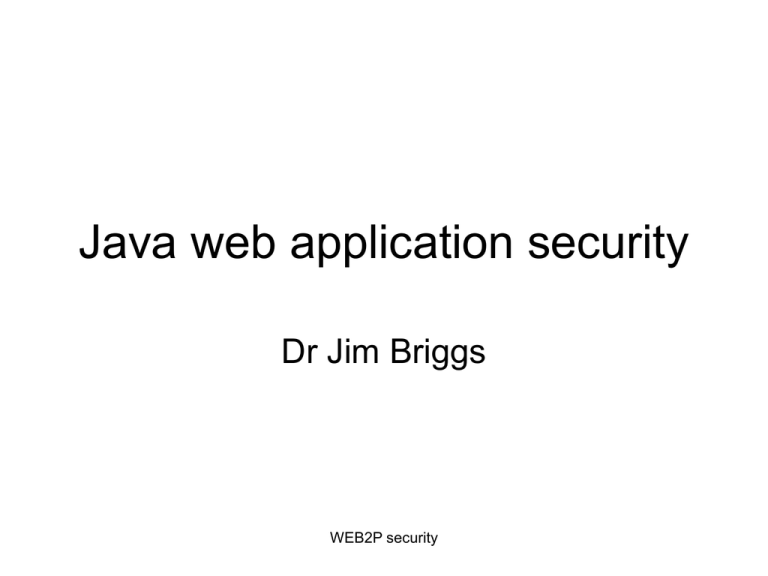
Java web application security Dr Jim Briggs WEB2P security What is security? • Usually ensuring that only authorised users can access specific parts of a website • Security has two basic concepts: – authentication: who is it? – authorisation: what can they do? WEB2P security Categories of security mechanism • Container-managed (e.g. Tomcat) – Specified as part of the Java Servlet Specification – However, the implementation is container specific (and therefore not necessarily portable between containers) • Application-managed – Independent of the container – However, you have to write the code yourself (or use some other mechanism) WEB2P security HTTP authentication • HTTP provides for authentication - see RFC 2617 • Operates on a challenge/response paradigm: – – – – Server receives a request for an access-protected object Server responds with a "401 Unauthorized" status code Client must then resend the request with an Authorization header Most browsers will prompt the user for a username and password • Most browsers cache this for the duration of the browser session • Some will allow the user to save it between sessions • Distinction between Basic Authentication and Digest Authentication: – Basic passes usernames and passwords in clear text (actually in Base64 format, but this is easily translatable) – Digest scrambles the password by sending a checksum (by default, MD5) of the username, the password, a given nonce value, the HTTP method, and the requested URI. The nonce value is sent by the server with the 401 response. • Realm is the zone of security – Effectively the store against which credentials are checked WEB2P security Mechanisms for securing Java web applications • • • • Fundamentals Container-managed techniques Application-managed techniques Mix and match WEB2P security Fundamentals • HTTP authentication • Secure Sockets Layer (SSL) • HTTP over SSL (HTTPS) – See how to set this up in Apache – See how to set this up in Tomcat – Unlikely to need latter if using Tomcat as auxiliary server (especially via AJP) WEB2P security Container-managed security • Security constraints in web.xml file – Authentication – Authorization – Secure transport WEB2P security Authentication <login-config> <auth-method>BASIC</auth-method> </login-config> <login-config> <auth-method>FORM</auth-method> <form-login-config> <form-login-page>/login.jsp</form-login-page> <form-error-page>/fail_login.html</form-error-page> </form-login-config> </login-config> WEB2P security Authorization <security-constraint> <web-resource-collection> <web-resource-name>Admin</web-resourcename> <url-pattern>/admin/*</url-pattern> </web-resource-collection> <auth-constraint> <role-name>private</role-name> </auth-constraint> </security-constraint> WEB2P security Secure transport <security-constraint> ... <user-data-constraint> <transport-guarantee> CONFIDENTIAL </transport-guarantee> </user-data-constraint> </security-constraint> WEB2P security Authentication methods • Basic - uses HTTP Basic Authentication • Digest - uses HTTP Digest Authentication • Form - presents a login form to the user <form method="POST" action="j_security_check"> <input type="text" name="j_username"> <input type="password" name="j_password"> </form> • Client certificate - requires digital certificate from client WEB2P security Tomcat realms • MemoryRealm – a file (tomcat-users.xml) in the TOMCAT/conf directory • JDBCRealm – specify tables and columns of a database that contain usernames, passwords and roles • DataSourceRealm – similar, but using a JNDI-named DataSource rather than a specific JDBC driver • JNDIRealm – looks up users in an LDAP directory server accessed by a JNDI provider • JAASRealm – authenticates users through the Java Authentication & Authorization Service (JAAS) framework WEB2P security Application-managed security 1 • Request properties: – request.getRemoteUser() – request.getUserPrincipal() – request.isUserInRole(role) • Use session attributes to store the user's identity • Use cookies to store username and password (can be persistent between browser sessions) WEB2P security Application-managed security 2 • Use a security filter • Use a base servlet • Use a custom JSP tag – forward request to a login page if the user is not logged in or does not have authorisation) • Struts facilities: – Use Struts roles (each action has a roles attribute) – Customise the Struts RequestProcessor • specifically the method processPreprocess – Use a Struts Base Action WEB2P security Mix and match • Many of the techniques can be used in combination • SecurityFilter (from Sourceforge.net) is an application-managed mechanism that mimics container-managed security WEB2P security


